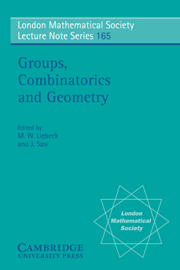Book contents
- Frontmatter
- Contents
- Authors' Addresses
- Introduction
- Part 1 Sporadic groups
- Part 2 Moonshine
- Part 3 Local and geometric methods in group theory
- Part 4 Geometries and related groups
- Part 5 Finite and algebraic groups of Lie type
- 22 Some remarks on the structure of finite subgroups of simple algebraic groups
- 23 Some (almost) multiplicity-free coset actions
- 24 Orbits in internal Chevalley modules
- 25 Subgroups of finite and algebraic groups
- 26 Irreducible representations of finite Chevalley groups containing a matrix with a simple spectrum
- 27 Overgroups of unipotent elements in simple algebraic groups
- Part 6 Finite permutation groups
- Part 7 Further aspects of simple groups
- Part 8 Related topics
26 - Irreducible representations of finite Chevalley groups containing a matrix with a simple spectrum
Published online by Cambridge University Press: 07 September 2010
- Frontmatter
- Contents
- Authors' Addresses
- Introduction
- Part 1 Sporadic groups
- Part 2 Moonshine
- Part 3 Local and geometric methods in group theory
- Part 4 Geometries and related groups
- Part 5 Finite and algebraic groups of Lie type
- 22 Some remarks on the structure of finite subgroups of simple algebraic groups
- 23 Some (almost) multiplicity-free coset actions
- 24 Orbits in internal Chevalley modules
- 25 Subgroups of finite and algebraic groups
- 26 Irreducible representations of finite Chevalley groups containing a matrix with a simple spectrum
- 27 Overgroups of unipotent elements in simple algebraic groups
- Part 6 Finite permutation groups
- Part 7 Further aspects of simple groups
- Part 8 Related topics
Summary
For a matrix M the set of its eigenvalues, counting multiplicities, is called the spectrum of M. If the multiplicity of every eigenvalue of M is equal to 1, we say that M has a simple spectrum. In certain situations it would be desirable to determine finite linear groups containing a matrix with a simple spectrum. We shall discuss some aspects of this problem.
Matrices with simple spectra often occur as matrices of linear transformations acting irreducibly on the underlying space. For finite fields the following problem has been studed by Hering for determining doubly transitive permutation groups.
Problem. Describe all linear groups H ⊂ GLn(q) which contain irreducible cyclic subgroup.
Observe that if a matrix c ∈ GLn(q) generates an irreducible subgroup, then the spectrum of c is simple. Note that Hering has considered the case where c is of prime order. Kantor has described subgroups of GLn(q) which contain a cyclic subgroup of order qn – 1. In a more general investigation Seitz has described (under certain restrictions) all subgroups of finite Chevalley groups containing a maximal torus.
If one tries to determine all finite linear groups containing a matrix with a simple spectrum, then one is forced to use the classification of finite simple groups and the representation theory since no other approach is available. This leads to a rather large program because it is necessary to examine representations of many classes of groups in various characteristics. We shall discuss in detail the following particular case which is an essential ingredient of the general problem.
- Type
- Chapter
- Information
- Groups, Combinatorics and Geometry , pp. 327 - 332Publisher: Cambridge University PressPrint publication year: 1992
- 1
- Cited by

